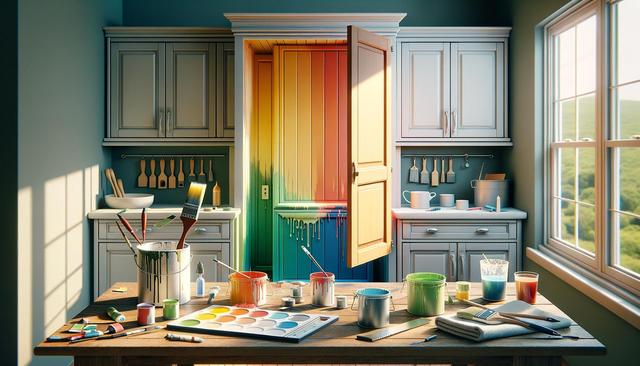
How to Paint Kitchen Cabinets Yourself: A Step-by-Step Guide
Planning and Prepping Your Cabinets
Before diving into painting, proper planning and preparation are essential. Start by evaluating your cabinets’ current condition. If the surfaces are damaged or warped, repairs or replacements might be necessary before painting. Next, remove all cabinet doors and hardware, such as handles, knobs, and hinges. Label each door and its corresponding location to make reassembly easier. Cleaning your cabinets is a crucial step—kitchen cabinets often have built-up grease and grime, which can prevent paint from adhering properly. Use a degreaser or a mix of warm water and dish soap to scrub all surfaces thoroughly.
Once cleaned, lightly sand the cabinet surfaces with fine-grit sandpaper (typically 120 to 220 grit) to create a smooth, paint-ready surface. Wipe off all dust with a tack cloth or damp rag. Cover surrounding areas with painter’s tape and drop cloths to protect your countertops, walls, and floors from paint splatters. Planning also includes choosing the right time—make sure you have a few days set aside, as this is not a one-day project.
Choosing the Right Paint and Tools
Selecting the appropriate paint type and tools is key to achieving a smooth, durable finish. For kitchen cabinets, a high-quality latex or oil-based paint is typically recommended because of their durability and easy-to-clean surfaces. Look for paint labeled for “cabinet and trim” or “furniture finish” for better results. You’ll also need a good bonding primer, especially if your cabinets are previously finished or made from laminate.
Essential tools include:
- High-density foam rollers for even application
- Angled synthetic brushes for corners and edges
- A paint sprayer (optional) for a professional-looking finish
- Sandpaper or a sanding block
- Painter’s tape and drop cloths
When selecting colors, consider the overall style of your kitchen. Lighter shades can make a space feel larger and more open, while darker tones offer a dramatic and modern look. Test a few colors on a small area first to see how they look in your kitchen’s lighting.
Priming Your Cabinets
Priming is a crucial step that ensures your paint adheres well and lasts longer. Start by applying a quality bonding primer to all cabinet surfaces. This is especially important if you’re painting over a dark finish or a glossy surface. Use a brush for detailed areas and a roller for flat sections to minimize brush strokes. Let the primer dry completely—usually about 24 hours, depending on product instructions and humidity levels.
After the primer dries, inspect the surface. If you notice rough patches or raised grain, lightly sand the surface again and wipe it clean. Applying a second coat of primer may be necessary for better coverage and durability. Priming not only helps the paint stick but also prevents stains and wood tannins from seeping through the paint over time.
This stage may feel time-consuming, but it lays the foundation for a high-quality finish. Skipping or rushing through priming can lead to peeling or chipping paint down the line, especially in a high-use area like the kitchen.
Painting the Cabinets
Once primed and sanded, it’s time to apply the paint. Start with the inside edges and openings of the cabinet frames, then move to the outer cabinet sides and face frames. Next, paint the cabinet doors and drawer fronts. Apply thin, even coats to avoid drips and runs. Let each coat dry thoroughly according to the paint manufacturer’s instructions—typically 4 to 6 hours between coats.
Two coats of paint are usually sufficient for solid coverage, but some colors may require a third layer. Sand lightly between coats to ensure a smooth final finish. Avoid rushing this process; patience here results in a more professional look. If you’re using a sprayer, practice on scrap wood first to perfect your technique and avoid overspray.
Allow the final coat to cure for at least 24 to 48 hours before handling. Full curing may take up to a week, during which it’s best to avoid heavy use. Once fully dry, reattach the hardware and reinstall the doors and drawers. This step-by-step approach ensures a long-lasting and attractive finish that can transform your kitchen’s appearance.
Maintaining Your Painted Cabinets
After completing your cabinet painting project, proper maintenance will help preserve the finish and keep your kitchen looking fresh. Painted cabinets are durable, but they still require regular care to stay in good condition. Avoid using harsh chemicals or abrasive sponges for cleaning. Instead, use a soft cloth and mild soap to wipe down surfaces as needed.
Keep an eye out for chips or scratches, especially around high-use areas like handles and drawer edges. Touch up any damage promptly using leftover paint to prevent peeling or moisture damage. If you notice hinges or handles becoming loose over time, tightening them will help maintain the integrity of your cabinets.
Humidity and temperature fluctuations can affect painted wood surfaces. Using a dehumidifier or proper ventilation in your kitchen can help minimize these issues. With the right upkeep, your newly painted cabinets can remain vibrant and beautiful for years, making your DIY effort truly worthwhile.
Conclusion: A Rewarding DIY Project
Painting your kitchen cabinets yourself can be a rewarding and cost-effective way to refresh your space. With careful planning, the right materials, and attention to detail, you can achieve a transformation that adds both visual appeal and value to your home. While the process requires time and patience, the results are often well worth the effort. Whether you’re aiming for a modern update or a classic refresh, painted cabinets offer flexibility and style without the need for a full renovation.


